- Submissions

Full Text
Trends in Textile Engineering & Fashion Technology
Study on Transmitted and Non- Transmitted Diseases in Garments Washing Sector in Bangladesh
Engr Md Eanamul Haque Nizam1*, Abed Zubaier2 and Avijit Kumar Das2
1Assistant Professor, Department of textile engineering, Southeast University, Tejgaon, Dhaka, Bangladesh
2Students, Department of textile engineering, Southeast University, Tejgaon, Dhaka, Bangladesh
*Corresponding author:Md Eanamul Haque Nizam, Assistant Professor, Department of textile engineering, Southeast University, Tejgaon, Dhaka, Bangladesh
Submission: July 31, 2023; Published: August 09, 2023

ISSN 2578-0271 Volume9 Issue1
Abstract
A rapidly expanding and crucial area of Bangladesh’s economy right now is garment washing. Numerous individuals depend on these industries. However, the issue of labor job migration is quite concerning in this industry. The main goals of this field are to determine the causes of and solutions for employment migration in Bangladesh’s garment washing and dying industry. The research teams directly interviewed more than 500 (Five Hundred) workers for this study. The actual causes of employment migration have been determined using 12 (twelve) different sorts of queries. The research team has provided recommendations for labor and authorities to reduce the quantity of work migration and the impact of transmitted diseases after assessing the feedback from the questions.
Keywords:Transmitted and Non-transmitted disease; Garments washing; Bangladesh
Introduction
Garment washing refers to the process of treating fabrics or clothing to achieve a desired
appearance, texture, and feel. It involves the use of various techniques and treatments to alter
the physical and visual properties of the fabric, such as its color, texture, and shape. Garment
washing can be performed using various methods, including mechanical, chemical, and
enzymatic processes [1]. Some common types of garment washing include stone washing, acid
washing, enzyme washing, and bleach washing. Garments washing is an important part of the
textile industry and consumers demand sustainable and eco-friendly products. The number of
user-friendly products continues to grow, and we expect to see some trends in the future to do
garments washing. In a few days, we can see that, most of the labor and worker from garments
washing has migrated [2,3]. There are different reasons behind the migrations. In this study,
the research team focused on transmitted/infectious diseases, which are infections that are
spread from person to person in a variety of ways, including sexual contact, contact with
bodily fluids, contaminated food, or water, and through the air [4]. Examples of transmitted
diseases include HIV/AIDS, gonorrhea, chlamydia, and hepatitis. Non-transmitted diseases,
on the other hand, are conditions that cannot be passed from person to person. These diseases
are often caused by genetic factors, lifestyle choices, or environmental factors. Examples of
non-transmitted diseases include diabetes, hypertension, cancer, and asthma [5] the textile
washing sector may be associated with the transmission of diseases. Some of these diseases
are transmitted through direct contact with contaminated clothing, while others are not
transmitted through clothing but may still affect workers in the washing sector [6,7].
A. To identify the different types of diseases that can be transmitted or non-transmitted
in the garments washing sector, including their causes and symptoms.
B. To assess the risk factors and exposure levels of workers in the garments washing
sector to these diseases, including potential sources of exposure and the use of protective
equipment.
C. To develop strategies and interventions to prevent the
transmission of diseases in the garments washing sector,
such as implementing health and safety policies and training
programs for workers and management.
D. To raise awareness among workers and management in
the garment washing sector about the importance of health and
safety, and the potential risks associated with working in this
industry.
E. To evaluate the effectiveness of the interventions and
strategies implemented in preventing the transmission of
diseases in the garments washing sector and recommend
further improvements if necessary.
F. To promote the health and safety of workers in the
garments washing sector by identifying and addressing the risks
associated with transmitted and non-transmitted diseases.
Material and Method
Materials
Questionnaire, Labor, Garments washing factory.
The materials of this project are data which were collected some questions to get relevant answers and to take the answers as data to later entry them on data entry sheet on Microsoft excel.
The questions are:
a) Question no 01: Are you working here for long time?
b) Question no 02: Are you happy to work here for long time?
c) Question no 03: Is it mandatory to wear mask during
work?
d) Question no 04: In the last few years are you affected.
1. by any type of skin diseases?
e) Question no 05: Why the workers switched their job?
f) Question no 06: In the few years, which type of diseases
you were affected?
This project aimed to investigate the prevalence of transmitted and non-transmitted diseases among individuals working in the garments washing industry. A total of 407 participants from different garment washing facilities and some other sectors were included in the study.
Methodology
This project aims to assess the prevalence of transmitted and non-transmitted diseases among workers in the garment washing sector.
This project was completed by three steps.
Step 1 - Planning and Preparation
1. Define the objectives.
A. The main prospect of this survey is to find out how people
who works in garments washing sector or dyeing sector gets
affected by various transmitted and non-transmitted diseases
because of getting exposed to various chemicals and other
substances while working.
B. Secondly, assessing the knowledge and awareness of
workers, evaluating the effectiveness of existing health and
safety measures.
2. Analyzing the theory
A. A good knowledge about garment washing sector and
transmitted and non-transmitted disease was needed before
starting the project. The main topics were selected for study to
understand the project.
B. In the theory part a study was done on garment washing
sectors. We learned about the types of washings there are. And
found out the relation between the chemicals and processes
they use and various diseases.
3. Factory decide
A. Factories with washing and dyeing facilities were chosen.
4. Design the survey questions:
A. Started with introductory questions to gather
demographic information (age, gender, etc.) and employment
details (years of experience etc.).
B. Included questions about general health, symptoms
experienced, and previous history of diseases.
C. Assessed the availability and utilization of safety
equipment, such as gloves, masks, or protective clothing.
D. Included questions about the work environment,
sanitation practices, and exposure to hazardous chemicals.
5. Labor selection
A. Male and female workers from various garment
departments such as wet wash, dry process, washing R&D, Yarn
dyeing, fabric dyeing, pp spray section etc were chosen. The
sectors where chemicals are mostly used and others equipment
with hazardous risks were significantly targeted.
B. Identified the workers from suitable departments who
will participate in the survey eagerly.
6. Obtain permissions
A. Sleeked approval from relevant authorities, such as
garment factory management, to conduct the survey on their
premises.
B. Ensured compliance with ethical considerations and
obtain informed consent from participants.
C. Followed any legal or institutional guidelines for
conducting research involving human subjects.
D. Clearly communicated to the participants that their
participation is voluntary, and their responses will be kept
confidential.
Step 2 - Data Collection
1. Pre-survey communication
A. Planned a communication strategy to inform the target
population (garment factory workers) about the upcoming
survey.
B. Clearly explained the purpose and benefits of the survey,
assuring participants that their responses will be anonymous
and confidential.
C. Address any concerns or questions raised by the
participants through information sessions or Q&A sessions.
2. Conduct interviews
a) Interviewed workers on the working floors of various
departments while they were working so that their work
doesn’t get effected by our survey. Some were doing very
delicate works, so we took their interview later at a suitable
time.
b) Took convenient times for conducting the survey at
the garment factories, considering the workers’ shifts and
workload.
c) Approached selected participants and administered the
survey questionnaire in person.
d) Used a standardized approach to ensure consistency in
data collection across all interviews.
e) Was respectful, patient, and empathetic towards the
participants, creating a comfortable environment for them to
share their experiences and concerns.
f) Allowed participants to ask questions or seek clarification
on any survey-related matters.
3. Data entry
A. Primarily, all the answers with details were written down
on the Q&A papers made by us.
B. Then, transferred the collected survey responses into
excel sheet for easier analysis and storage.
C. Utilized appropriate software tools to enter the data more
efficiently.
D. Ensured data entry personnel are trained in data handling
procedures and maintained data security measures.
Result and Discussion
Now we will discuss about our various data that we got from our interviews. We will be using some tables and graphs to describe our findings and thoughts on it more smoothly. The participants were predominantly male 222 (55%) and female 185 (45 %) (Table 1).
Table 1:Gender analysis.

The first graph illustrates the percentage of workers that we interviewed based on gender. The graph is divided into two bars: one for male respondents and the other for female respondents. Among the total respondents, approximately 55% were male, and 45% were female. This distribution was considered while analyzing the disease prevalence. The findings suggest a relatively equal risk of transmitted diseases among male and female workers (Figure 1) (Table 2).
Figure 1:Gender analysis.
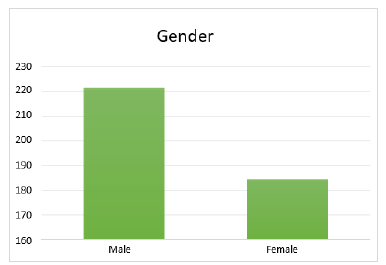
Table 2:Age analysis.

People of different ages were interviewed which includes- Workers of age under 20=2 (0.5%), age between 20-30 =217 (53%), age between 31 - 40 = 122 (30%), age between 41 – 50 = 47 (12%), age between 51-60=17(4%), age over 60=2 (0.5%).
The second graph presents the age distribution of the survey participants in the garment washing sector. The graph shows a clear breakdown of participants by age, allowing us to understand the composition of the surveyed population. Most workers that work in the garment sector are around the age between 20 to 40 years of age with 83% because they seem more physically capable. People under 20 and people above 60 are rare with only 1%. And workers of age between 41 to 60 are 16%. People from different ages get sick with many transmitted and non-transmitted diseases. People above 40 years of age get more disadvantaged while fighting these diseases (Figure 2).
Figure 2:Age analysis.
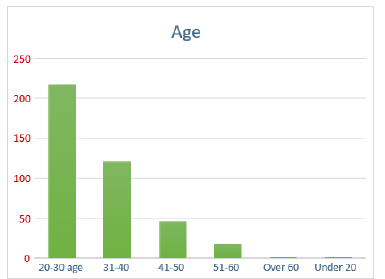
We asked the workers if they were working in their respective factories for a long time. 295 (73%) of them said yes and 112 (27%) of them said no (Table 3).
Table 3:Analysis of the feedback of question number 01.

The third graph shows the number of workers that have answered our question with yes or no.
The majority of the people, 73% of the total number of workers said that they were working here for a long time while the remaining 27% said that they were not. Despite having less safety measurements and salary most of the people remain at their respective garments. This is because of less scope of jobs around other factories and inability in other work sectors (Figure 3).
Figure 3:Q 1 - Are you working here for long time?
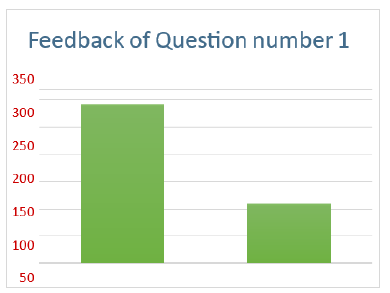
Our second question was whether they were happy to work in their factories for a long time. 220 people said yes (54%), 49 people said no (12%) and 138 people remained neutral (34%) (Table 4).
Table 4:Analysis of the feedback of question number 02.

Majority of the people with 54 % said they were happy to work in their factories for a long time. This group of people is either happy with their salary or satisfied with their current form of job (Figure 4).
Figure 4:Q2 - Are you happy to work here for long time?
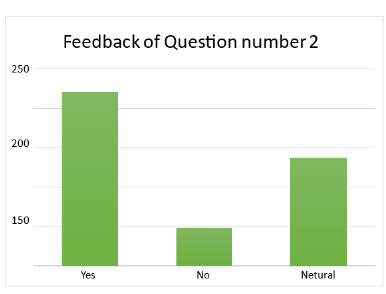
A little group of people with 12 % of the total number said they were unhappy. They face various problems while working in their sectors. Some of them are under paid and some of them are not happy with their working environment and nature of their work. 34% of people remained neutral and didn’t want to say anything about their feelings. Still people from these three types of people get effected by various transmitted and non-transmitted diseases (Table 5).
Table 5:Analysis of the feedback of question number 03.

The next question was whether it was mandatory for them to wear mask during work. 364 workers from various sectors said yes (89%) and 43 workers said no (11%).
In this graph, we have plotted the number of workers who considered wearing a mask mandatory during their work hours. Majority of the workers said yes with 89% of total number and 11% said no. Across all departments, there is a significant variation in the workers’ perception of mask- wearing. For example, the production department, dyeing department and washing department had the highest percentage of workers who considered wearing masks mandatory. This indicates the importance of considering department-specific measures for disease prevention (Figure 5).
Figure 5:Q 3 - Is it mandatory to wear mask during work?

Top three reasons for considering mask-wearing mandatory
were
a) Protection against airborne contaminants,
b) Prevention of respiratory infections,
c) Compliance with occupational health and safety
legislation.
The most common challenges reported were discomfort due to prolonged mask use, difficulty in communicating effectively (28% of workers reported this), and inadequate mask availability (22% of workers reported this). These findings suggest the need for interventions such as providing more comfortable masks and addressing communication barriers while ensuring an adequate supply of masks.
That’s why many factories as well as their workers didn’t consider wearing mask should be mandatory. These findings demonstrate varying perceptions among workers regarding the mandatory use of masks during work in the garments washing sector. It is crucial to consider Specific measures from the department, raise awareness of the importance of wearing a mask in order to promote a safer and healthier working environment, respond to the challenges faced by workers. Assessing the impact of education and training programs on workers’ understanding of the importance of mask-wearing is crucial. The potential long-term implications of not wearing masks in the garments washing sector can include the risk of disease outbreaks, impact on workers’ health, and the economic consequences of absenteeism or decreased productivity. Emphasizing the importance of preventive measures like maskwearing can help mitigate these risks [8]. In this evaluation, it can be useful to identify whether existing initiatives are effectively communicating the benefits of wearing masks and if there is a need for additional training to address misperceptions or lack of knowledge (Table 6).
Table 6:Analysis of the feedback of question number 04.

The results were obtained by asking participants whether they had been affected by any diseases in the last few years. Out of the total respondents, 242 individuals reported being affected by diseases (59%), while 165 individuals stated that they had not been affected (41%) (Figure 6).
Figure 6:Q 4 - In the last few years are you affected by any type of skin diseases?

Through this graph the distribution of responses can be visualized. The graph has two bars, one representing the number of people affected by diseases 242 (59%) and the other representing the number of individuals who were not affected 165 (41%). The height of each bar would indicate the respective count of respondents. When examining the distribution of responses through a graphical representation, it becomes evident that a considerable number of workers have been impacted by diseases. The bar chart clearly demonstrates the disparity between the two groups, with the bar representing individuals affected by diseases being notably higher than the bar representing those unaffected. These findings raise concerns about the health and safety conditions within the garments washing sector and others. The relatively high number of workers reporting diseases indicates a potential risk for the transmission or prevalence of illnesses in the workplace. It suggests that there might be underlying factors such as poor sanitation practices, inadequate safety measures, or exposure to harmful substances that contribute to the occurrence of diseases. The implications of these results are significant for both workers and employers in the garments washing sector. Health issues can not only have a detrimental impact on individual workers but also disrupt productivity and the overall functioning of the industry. It is crucial for stakeholders to address these concerns and take appropriate measures to safeguard the well-being of workers [9,10].
Participants were asked about their reason for switching jobs. 374 people said it was for salary (92%) and 33 people said it was for health problem (8%) (Table 7).
Table 7:Analysis of the feedback of question number 05.

This graph demonstrates, when asked about the primary reason for switching jobs, a significant majority of 374 individuals (92%) attributed their decision to salary-related factors. It is apparent from this assessment that financial considerations played a very important role in the workers’ decision to change their workplace. In contrast, a smaller group of 33 respondents (8%) mentioned health problems as the main reason for switching jobs. This minority indicates that a portion of the workers experienced health-related issues, which prompted them to seek alternative employment opportunities. This data indicates a clear discrepancy in the motivating factors behind job switching within the garments washing sector and others. While many workers sought higher salaries, a smaller proportion identified health problems as the driving force behind their decision. These findings provide valuable insights into the workforce dynamics and can help inform strategies aimed at improving employee retention and well-being within the sector. When asked about getting affected by any type of diseases many answered with transmitted diseases and some with nontransmitted diseases. Some had both type diseases. Some had none. We separated the answers into two subdivisions (Figure 7).
Figure 7:Q 5 - Why the workers switched their job?
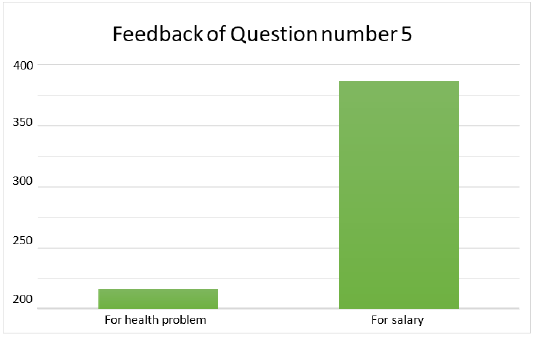
For transmitted diseases , 8 people were affected by Tuberculosis (2%), 4 people were affected by Measles (1%), 4 people were affected by Rubella (1%), 14 people were affected by Pneumonia (3.5%), 6 people were affected by Hepatitis A (1.5%), 17 people were affected by Hepatitis B (4.5%), 22 people were affected by Cholera (5.5%), 2 people were affected by Meningitis (0.5%), 80 people were affected by Influenza ( like : swine flu) (20%) & 281 people weren’t affected by any transmitted diseases (69%) (Table 8).
Table 8:Feedback of the question number 06.

This graph illustrates Among the surveyed workers, a total of 126 individuals reported being affected by transmitted diseases (31%). Conversely, 281 workers stated that they were not affected by any transmitted diseases (69%). The above data indicates that a notable proportion of workers in the garments washing sector have experienced transmitted diseases. It could be crucial to identify the specific types of transmitted diseases prevalent in this sector and take appropriate measures to prevent their spread (Figure 8). Among the affected individuals, the highest number of cases was related to influenza, with 80 workers reporting this disease which is almost 20% of the total participants. Hepatitis B affected 17 individuals, cholera affected 22 individuals, and pneumonia affected 14 individuals. These are the major concerning diseases that are seen amongst the workers. There were also a few cases of other diseases reported by the remaining participants. This data suggests that influenza is the most reported transmitted disease among the surveyed workers, followed by cholera, Hepatitis B and pneumonia. The relatively low number of cases for other diseases such as-Tuberculosis, Measles, Rubella, Hepatitis A & Meningitis indicates their less frequent occurrence in the garment washing sector. By comparing the frequencies of different diseases, we can identify the most common ones that affect workers in the garment washing sector. This information is crucial for assessing the health risks associated with specific diseases and developing targeted prevention and intervention strategies [11].
Figure 8:Affected by transmitted diseases List.
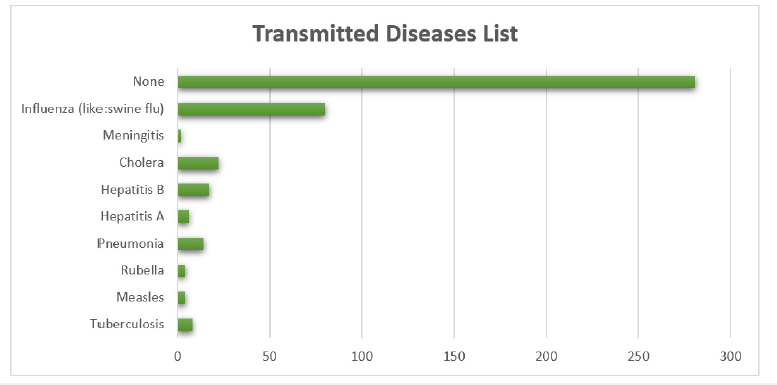
Additionally, it would be beneficial to conduct further analysis to understand the factors contributing to the prevalence of these diseases. This may involve investigating workplace conditions, hygiene practices, vaccination coverage, and other relevant variables. Such insights can guide the implementation of appropriate health and safety measures to protect the well-being of the workers.
For non-transmitted diseases, 57 people were affected by Diabetes (14%), 20 people were affected by cardiovascular disease (5%), 76 people were affected by Hypertension (19%), 19 people were affected by Stroke (4.5%), 24 people were affected by Chronic respiratory disease. (Lung cancer) (6%), 6 people were affected by Cancer (1.5), 48 people were affected by Toxic liver disease (12%), 207 people were affected by Dry cough (51%) and 102 people said they weren’t affected by any non-transmitted diseases (Table 9).
Table 9:

Affected by non-transmitted diseases List This graph shows the number of people affected by various non-transmitted diseases (Figure 9). According to the graph, a total of 102 workers reported not being affected by any non- transmitted diseases. This indicates a relatively healthy segment of the workforce. However, it’s crucial to note that this doesn’t imply they are completely immune to all diseases, as they may still be susceptible to transmitted diseases. Among the surveyed workers, dry cough was the most reported non-transmitted disease, affecting 207 individuals. This highlights a potential occupational health concern, as dry cough can be caused by various factors such as exposure to dust, chemicals, or inadequate ventilation in the workplace. Hypertension, a chronic condition characterized by high blood pressure, was reported by 76 workers. This finding is significant, as hypertension is known to be influenced by lifestyle. Factors, including stress and physical activity levels. Implementing measures to promote healthier habits and stress management among workers could help mitigate this issue.
Figure 9:Affected by non-transmitted diseases List.

The survey also revealed that 57 workers reported having diabetes. Diabetes is a metabolic disorder that requires proper management and can be influenced by factors like diet, exercise and genetics. Raising awareness about healthy eating habits and providing resources for diabetes management could be beneficial for these individuals.
Toxic liver disease was reported by 48 workers. This finding suggests a potential occupational hazard, possibly associated with exposure to chemicals or toxins in the garments washing sector. Ensuring proper safety protocols, handling hazardous substances cautiously and implementing regular health check-ups may help prevent or detect such conditions.
Other non-transmitted diseases reported include cardiovascular disease (20 workers), stroke (19 workers), chronic respiratory disease (lung cancer) (24 workers), and cancer (6 workers). Each of these conditions carries its own implications and may require targeted interventions, such as promoting heart-healthy practices, providing stroke prevention education, and implementing workplace policies to reduce exposure to carcinogens. The rate of workers affected by non-transmitted diseases is higher than transmitted diseases.
Overall, this study has revealed the prevalence of various transmitted diseases and non-transmitted diseases amongst workers in the garment washing industry. The findings emphasize the need for comprehensive occupational health programs, including regular medical check-ups, health education, and improved workplace safety measures, to ensure the well-being of the workforce. By addressing these health concerns, we can strive to create a healthier and safer working environment for all employees in=the=industry.
From our extra questions we came to know about the tonics workers take when they get ill. It was clearly seen that most of them don’t go for a proper medical checkup. Rather than that they often go to nearby pharmacies. This happens because of their poor salary margin and lack of facilities provided by surroundings.
Prevention
Self-awareness is the key to sound health. But sometimes a little push is all a person could ask.
Exact prevention of transmitted and non-transmitted diseases from garment washing sectors cannot be done. But it can be minimized by various steps [12]. such as A. Awareness and Education: Increasing the awareness of workers regarding disease transmission and prevention. Questioning workers about their knowledge of good hygiene techniques, e.g. handwashing, use of personal protection devices and the correct handling of chemical substances. B. Access to Resources: Determining if workers have access to necessary resources for disease prevention, such as clean water, soap, hand sanitizers and appropriate PPE. Evaluate the availability and adequacy of these resources in the workplace. C. Work Environment: Evaluating the cleanliness and sanitation practices in the garments washing sector. Assessing if there are proper waste management systems, ventilation, and regular cleaning protocols in place to minimize disease transmission risks. D. Policies and Training: Examining the existence and effectiveness of workplace policies and training programs related to disease prevention. Determine if there are regular training sessions on hygiene practices, proper use of PPE, and occupational safety protocols. E. Reporting and Response Mechanisms: Inquiring about the presence of reporting mechanisms for disease outbreaks or symptoms among workers. Assessing if there are protocols in place for immediate response, including isolation procedures, contact tracing, and medical support. F. Behavioral Practices: Gathering information on the practices of workers, such as sharing personal items, eating in designated areas, and adherence to hygiene protocols. Assessing if these behaviors align with recommended guidelines for disease prevention.
Some additional steps considering medication [13]
A. Awareness of Medications: Inquiring about the level of awareness among workers regarding different medicinal products used for the treatment of transmitted and nontransmitted diseases. B. Access to Medications: Determining if workers have easy access to necessary medications. This includes assessing the availability of medications in the workplace or nearby pharmacies, as well as the affordability of these medications for workers. C. Usage Patterns: Exploring the frequency and consistency of medication usage among workers. Understanding their adherence to prescribed treatments can provide insights into potential gaps in healthcare access or education. D. Side Effects: Investigating whether workers are aware of possible side effects of medications they may be taking. This can help identify any adverse effects experienced by workers and inform the need for proper guidance or medical support. E. Medical Check-ups: Inquiring about the frequency and availability of medical check-ups for workers in the garments washing sector. Assessing if there are regular health screenings or examinations conducted to identify potential health issues and provide appropriate medical interventions. F. Preventive Measures: Assessing if workers are informed about preventive medications or vaccinations related to specific diseases prevalent in the garments washing sector. This can help gauge the effectiveness of health education initiatives and identify areas for improvement. G. Vaccination Programs: Investigating the existence and effectiveness of vaccination programs targeting common infectious diseases. Determining if workers are informed about the importance of vaccinations and assessing the availability and administration of vaccines in the workplace or through healthcare initiatives. H. Supportive Measures: Inquiring about the availability of support systems or healthcare provisions within the workplace. This includes access to medical professionals, provision of first aid kits, or designated healthcare facilities. I. Health Insurance: Exploring if workers have access to health insurance schemes that cover medical expenses and facilitate regular check-ups. Determining if such insurance schemes are provided by employers or through government initiatives. J. Referral Systems: Assessing the availability of referral systems for workers who require specialized medical attention. Determining if there are established mechanisms to refer workers to healthcare professionals or hospitals in case of serious health issues.
Conclusion
Our comprehensive project survey has provided critical insights into the health risks faced by workers in the garments washing sector in Bangladesh. The prevalence of both transmitted and non-transmitted diseases among the workforce highlights the urgent need for significant improvements in occupational health and safety practices. Transmitted diseases, such as bacterial and fungal skin infections, have been a prevalent concern among the workers. These diseases can be attributed to direct contact with contaminated water and chemicals used in the washing processes. Moreover, inadequate sanitation facilities and improper handling of wastewater have contributed to the propagation of infectious agents, posing serious health risks to the workforce.
Non-transmitted diseases, particularly respiratory issues, have also been alarmingly widespread. Workers exposed to dust particles, lint, and chemical fumes during the washing and drying processes are at a heightened risk of developing chronic respiratory conditions. This problem is aggravated by a lack of adequate ventilation, which also affects the respiratory health of employees.
The low level of awareness about disease prevention and health hazards, both among the workers and factory management, is a significant concern. This lack of knowledge translates into inadequate implementation of preventive measures and the use of protective gear.
Recommendation
As we all know if a worker gets affected by any disease and
become unable to work frequently it brings damages not only for the
worker but also for the factory itself. As we were advancing through
this project and its chapters, we felt some recommendations might
be good enough for extra support. For Factory Authorities
A. Implement regular hygiene training programs for workers
to educate them about disease prevention measures.
B. Provide adequate handwashing facilities with clean water,
soap, and hand sanitizers throughout the factory premises.
C. Provide for the availability and use of Personal Protection
Equipment, PPE like gloves, masks or goggles where necessary.
D. Regularly clean and disinfect frequently touched surfaces
and common areas within the factory.
E. Establish protocols for identifying and reporting any
suspected cases of diseases to the appropriate authorities.
F. Encourage workers to seek medical attention promptly if
they experience any symptoms or feel unwell.
G. Promote a culture of openness and communication,
allowing workers to voice their concerns or suggestions
regarding disease prevention measures.
For workers
a) Wash hands frequently with soap or water for a minimum
of 20 seconds and use hand sanitizers if soap isn’t available.
b) Adhere to the proper use of personal protective equipment
(PPE) as instructed by the factory authorities, if not possible at
least mask
c) Avoid close contact with coworkers or others who show
signs of illness, and maintain a
d) safe distance whenever possible.
e) When you cough and sneeze, practice respiratory hygiene
by wearing a tissue or an elbow over your mouth and nose.
f) To minimize the risk of contamination, do not touch your
face, in particular your eyes, nose and mouth.
g) Cooperate with health screening measures implemented
by the factory, such as temperature checks or symptom
assessments.
Inform the factory authorities promptly if you experience any symptoms or suspect exposure to a disease.
Limitation of this Project
It is worth noting that this survey project solely relied on selfreported data, which may introduce certain limitations. Factors such as recall bias or underreporting could potentially impact the accuracy of the results. To gain a comprehensive understanding of the situation, future studies could consider incorporating additional objective measurements or conducting follow-up interviews to gather more detailed information.
References
- Ahmed S, Sultana S, Sarker MSK, Talukdar AK (2021) Prevalence and factors associated with COVID-19 among workers in the garments washing sector in Dhaka, Bangladesh. Journal of Preventive Medicine and Public Health 54(5): 361-368.
- Begum F, Hasan MR, Islam MR, Islam MN, Rahman MM (2021) Prevalence of musculoskeletal disorders among garments washing workers in Dhaka City. International Journal of Medical Research & Health Sciences 10(6): 83-87.
- Mamun MM, Sultana MS, Khan MA, Rahman MM, Islam MS (2019) Prevalence of Hepatitis B virus infection among garments workers in Narayanganj, Bangladesh. Bangladesh Journal of Medical Microbiology 13(1): 25-30.
- Rahman MA, Rahman MM, Ali MN (2016) Prevalence of Hepatitis B virus infection among garment workers in Dhaka, Bangladesh. Journal of Medical Sciences 16(2): 43-46.
- Ahmed S, Hoque SF, Islam MS, Islam MR, Kamruzzaman M (2018) Prevalence of HIV, Hepatitis B and Syphilis among garments workers of Dhaka City, Bangladesh. Journal of Medicine 19(2): 80-83.
- Islam MR, Parvin R, Uddin MZ, Hasan MM, Hasan MK (2020) Prevalence of HIV, Hepatitis B and C among garments workers in Dhaka City, Bangladesh. European Journal of Preventive Medicine 8(1): 1-6.
- Khandker SS, Uddin MS, Hossain MF (2017) Prevalence of respiratory problems among the workers of garments washing industry in Dhaka City, Bangladesh. Journal of Environmental and Occupational Science 6(2): 46-51.
- Rahman MA, Alam MM, Islam MS (2018) Workplace violence and associated health outcomes among workers in garments washing industry of Dhaka City, Bangladesh. Journal of Environmental and Occupational Science 7(1): 1-7.
- Hossain MA, Islam MM, Khan MR (2019) Prevalence and associated factors of work-related injuries among the workers of garments washing Industry in Dhaka City, Bangladesh. Journal of Environmental and Occupational Science 8(1): 1-7.
- Amin MS, Ali MM, Rana MS (2020) Acute pesticide poisoning among the workers of garments washing industry in Dhaka City, Bangladesh. Journal of Environmental and Occupational Science 9(2): 57-63.
- Islam MR, Hossain MA, Hossain MM (2021) Prevalence of reproductive health problems among female workers in the garments washing industry of Dhaka City, Bangladesh. Journal of Environmental and Occupational Science 10(1): 27-34.
- Chowdhury MMH, Banik S, Haque MN, Bari MS (2017) Prevalence of Hepatitis B virus infection among garments washing workers in Dhaka City, Bangladesh. Journal of Microbiology Research 7(2): 25-30.
- Islam MT, Siddique MA, Hasan MM (2020) Prevalence of COVID-19 among garments washing workers in Dhaka City, Bangladesh. Journal of Health Research 34(6): 509-517.
© 2023 Engr Md Eanamul Haque Nizam. This is an open access article distributed under the terms of the Creative Commons Attribution License , which permits unrestricted use, distribution, and build upon your work non-commercially.
 a Creative Commons Attribution 4.0 International License. Based on a work at www.crimsonpublishers.com.
Best viewed in
a Creative Commons Attribution 4.0 International License. Based on a work at www.crimsonpublishers.com.
Best viewed in 







.jpg)






























 Editorial Board Registrations
Editorial Board Registrations Submit your Article
Submit your Article Refer a Friend
Refer a Friend Advertise With Us
Advertise With Us
.jpg)






.jpg)














.bmp)
.jpg)
.png)
.jpg)










.jpg)






.png)

.png)



.png)






